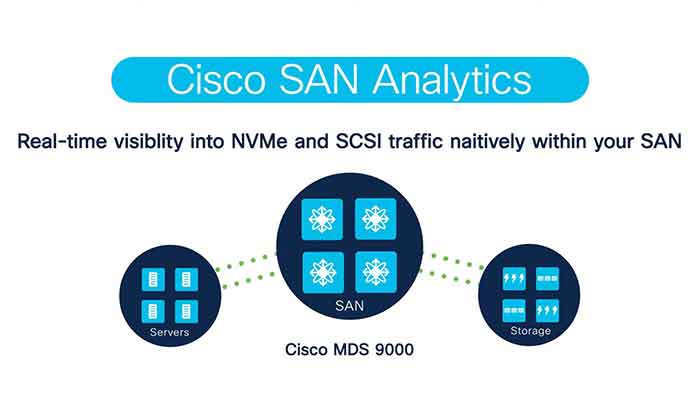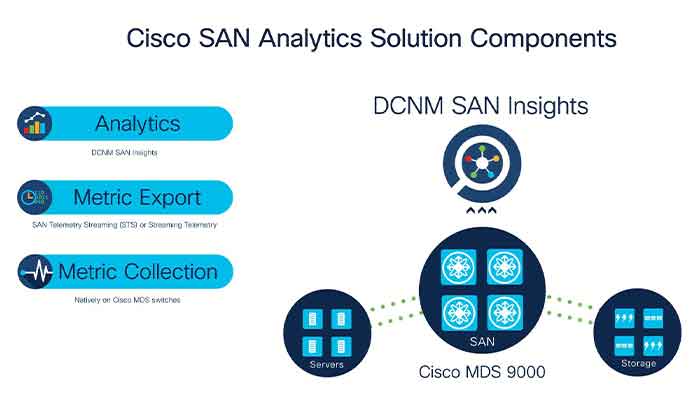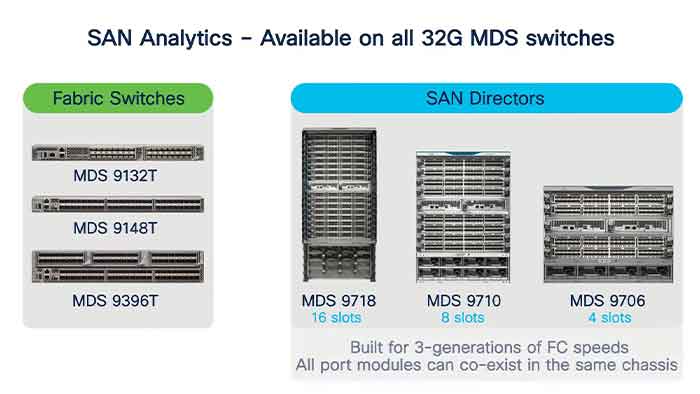
Cisco SAN Analytics is the industry’s first and only integrated by design architecture that provides you deep visibility into every transaction of your block storage traffic and IO flow, natively within your site. It requires no external hardware Apps, appliances or SPAN related traffic. Cisco SAN analytics is fully integrated with MDS 9000 switches and Cisco Data Center Network Manager or Cisco DCNM. By enabling one command, you will get the full view of the entire infrastructure. Overall, Cisco SAN Analytics is simple and affordable like no other solution before.
Todays, enterprises need “at-the-scale” visibility but it not easy as there are so many types of servers, uplink systems, storage arrays, different vendors’ architecture and etc. To solve complex troubleshooting, Cisco came with a simple yet extremely powerful approach. Since the IO command between the compute and the SAN storage layers are transported by the storage fabric, the MDS 9K switches do a deep packet inspection of the frames all the way to the Fibre Channel, SCSi/NVMe headers to calculate storage performance metrics.
These metrics are calculated natively within the switches in absolute real-time. In fact, some of the metrics have a granularity in microseconds. The storage performance metrics are calculated by inspecting wired data, so there is no dependency on the whole operating systems, virtualized or bare-metals or storage array architectures. If the application accesses storages using standard based SCSi and NVMe commands, Cisco SAN Analytics sees those transactions and reports the oral health.
At any instance, the Cisco MDS switches are collecting millions of performance metrics, but actionable insights are needed. For this matter, switches export the data to the Cisco DCNM for advanced analytics, end-to-end correlation and long-term trending.
Now, DCNM which includes analytics engine or SAN Analytics will handle these terms. This is where you will get ready-made answers and automatically calculates baseline and any deviation from the baseline results in automatic categorization of end devices into Green, Yellow, Orange or Red. So next time that problem happens, the administrator knows when, why and where it happened.

The overall solution has three major components. First, Cisco SAN analytics but the term is overloaded and also used for a feature on the MDS switches to natively collect I/O flow metrics. After the collection the metrics are exported using streaming telemetry or sand telemetry streaming or just SDS in short. Note that metric collection and metric export are two independent components. This design has several benefits like collect the metrics just once, but export to multiple destinations at the same time.
Also, you may choose not to export the metrics at all and just use the on switch CLI to get real-time visibility during low-level active troubleshooting. But, the real power comes when you export the metrics from multiple switches across the fabric to a centralized analytics application for end-to-end correlation. The metrics are exported using the open format of protocol buffers, so that you can send this data to your own data lake.
While building your own analytics application is totally possible, you should definitely try Cisco’s own SAN insights which is an advanced analytics and correlation engine within data center network manager or DCNM. It’s the same application that you have been using for fabric configuration and monitoring.

Overall, SAN Analytics is the name of the solution and it’s also the feature on the MDS switches to collect I/O flow metrics, streaming telemetry or STS, is an export mechanism, while SAN Insights is a feature in DCNM. In Cisco SAN Analytics architecture, all the heavy lifting of the data traffic inspection and metric collection is done by the port ASIC and the onboard NPU which causes minimal load on the control plane CPU of the switch and the involvement of the control plane CPU is limited to the metric export only.